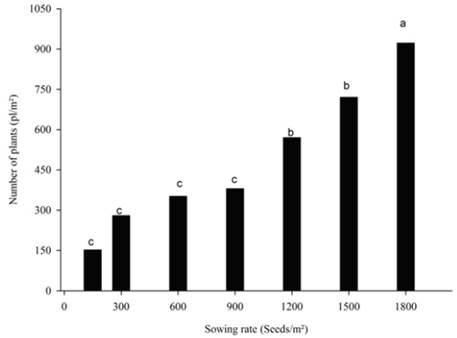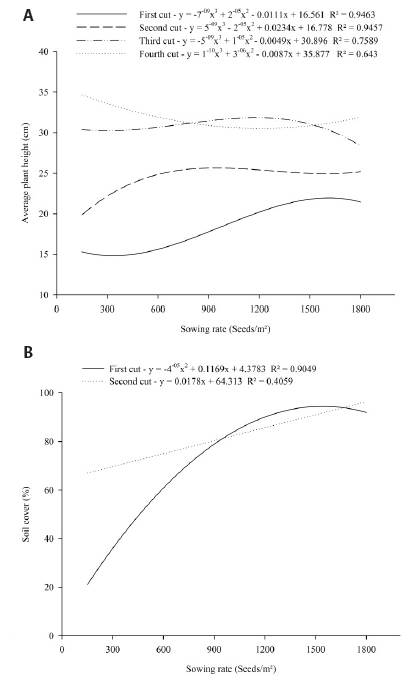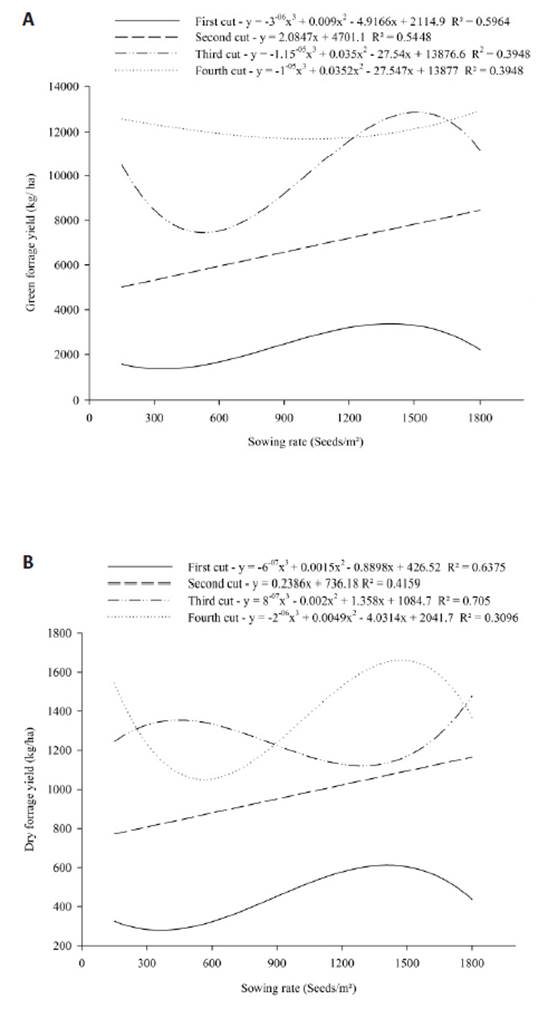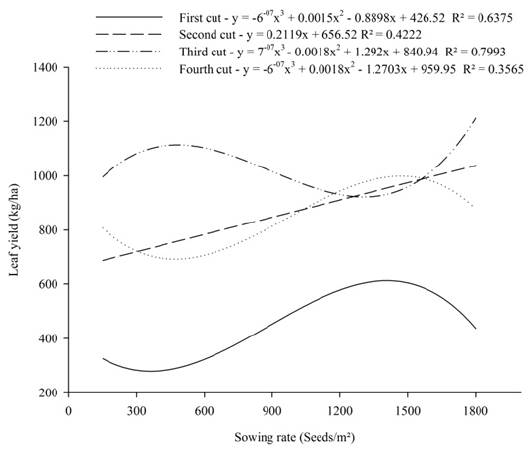Introduction
The genus Lolium, originally from Southern Europe, Western Asia and North Africa, comprises eight species, including L. multiflorum Lam., commonly known as ryegrass, an allogamous plant with wide geographical distribution in temperate regions (Nelson et al., 1997).
The ryegrass stands out for its importance as a winter forage due to its abundant forage production, high tolerance to grazing (Galvan, et al., 2011), good initial force and high reseeding natural, important feature for pasture improvement or the constitution of cultivated pastures (Oliveira et al., 2019).
In addition to these characteristics, these species provides both pastures and forages with a high level of conservation, such as hay, used alone or in consortium with other annual or perennial grasses, which further highlights the versatility of the grass (Havilah, 2017).
In the Southern region of Brazil, ryegrass is considered to be one of the forage species that stands out the most for its morphology and nutritional composition, responsible for much of the feeding of beef and dairy cattle, used both as pasture and in the production of silage and hay (Oliveira et al., 2019).
The sowing rate, as well as the number of plants per square meter, is one of the factors that most affect the plant morphogenesis, described as the dynamics of generation and expansion of the shape of the plant in space (Lemaire & Chapman, 1996). Seed quality is a key factor in achieving the desired plant density (Huth et al., 2020). The rate of leaf elongation and the appearance of leaves are among the morphogenic variables determining the main structural characteristics of pastures, such as leaf size, tiller production and forage yield (Pontes et al., 2003).
Despite its constant use, there are still doubts regarding the sowing rate to be applied to ryegrass (Mello & Carbonare, 2019), since population management must consider a series of factors, such as soil type, environmental conditions, seed size and average weight of one thousand seeds, a variable characteristic even within the same species, depending on the level of ploidy. Tetraploid accessions, for example, have significantly larger seeds compared to diploid seeds (Sugiyama, 1998). In addition to these, ploidy determines morphological changes in the plant, which must be considered for the indication of the sowing rate to be used (Rios et al., 2019).
Tetraploid ryegrass cultivars have wider leaves with darker coloring, in addition to a longer vegetative cycle, greater precocity, higher demand on soil fertility and greater tiller production, compared to diploid cytotypes. Also, there is a great difference in the average seed weight between the two types of cultivars (Sugiyama, 2006). Furthermore to the morphological traits that distinguish diploid and tetraploid cultivars, the differences among ploidy levels can extend to pasture management, determining the best time for mowing, recommending the point of greatest mass accumulation in relation to the highest nutritional quality (Oliveira et al., 2014).
Considering that there is still a lack of information about the appropriate sowing rate for different cytotypes (Mello & Carbonare, 2019), the present study was developed with the objective of determining the optimal sowing rate for ryegrass tetraploid cultivars.
Material and methods
Panel of ryegrass access and experimental procedures
The experiment was accomplished in 2019 at the Estação Experimental Terras Baixas (31°52’00’’S, 52°21’24’’W, 13.24 m above sea level) of Embrapa Clima Temperado, in the municipality of Capão do Leão, Rio Grande do Sul State, Brazil. Treatments were seven sowing rates: 150, 300, 600, 900, 1200, 1500, 1800 seeds per square meter (seeds/m2). They were sowed on May 6th, 2019 in a randomized block design with three replications. The tetraploid ryegrass population used is LOL 222 from Embrapa’s Ryegrass Breeding Program. It’s a result of polyploidization and selection of populations collected at Rio Grande do Sul State, Brazil (Pereira et al, 2014; 2017). Germination was determined as 92 % in a laboratorial test according with official rules (Brasil, 2009). Plots consisted of five lines with three meters of length, 0,2 m apart. mechanical cuts were done, on 07/10, 08/6, 09/18, and 10/11/2019, leaving a residual height of seven cm. Before the first and second cuts, soil cover (%) in each plot was accessed. In all cuts the following traits were measured: plant height (cm) -mean of three plants per plot; green forage yield (kg/ha)- in a sample of 0.25 m2; dry forage yield (kg/ha) -sample was dried in a forced air oven to constant weight; leaf yield (kg/ha)- leaf blades were separated from the dried sample.
Statistical analysis
The data were submitted to a normality test by Shapiro-Wilk (1965) to determine if it meets with the assumptions of the analysis of variance. Based on the results of the normality test, the data of green forage yield and leaf yield were transformed by means of the square root (SQRT) to reach the normality of the residues. Afterwards, the analysis of variance was performed in a split plot scheme, where the sowing rate and the cuts were considered as plot and subplot, respectively. To verify the behavior of the plants in each cut, regression analysis was performed considering the average number of repetitions of each variable. For the variable number of plants per square meter (pl/m2), cluster analysis of Scott Knott means was performed. The probability of 5 % error (p < 0.05) was considered for all analyzes. The statistical procedures were performed using the SAS software (Freud & Littell, 1986).
Results
According to the analysis of variance, for the variables average plant height (cm), percentage of soil cover (%), leaf yield (kg/ha), green forage and dry forage yields (kg/ha) there was a significant interaction between cuts and sowing rate. There is no significant interaction for the variable number of plants per square meter (pl/m2). All variables evaluated showed a significant difference between the applied sowing rates. In the present work, sowing rate affected the performance of ryegrass plants in all the cuts made in the crop (Figures 1 to 4).
The results showed that the sowing rate of 1800 seeds/m2 produced about 920 plants/m2 and was the largest stand obtained. The densities of 1200 and 1500 seeds/m2, did not differ statistically, with 570 and 720 plants/m2, respectively (Figure 1).

Figure 1 Comparison between mean number of plants per square meter (pl/m²) for different seeding densities (seeds/m²) for tetraploid ryegrass.
Regarding the influence of sowing rate on plant height, it is possible to observe that for the first crop cut there was an exponential growth in the average height of plants up to the density of 1500 seeds/m2, starting a slight reduction in 1800 seeds/m2, while in the third cut this reduction was more accentuated for denser sowing rates (Figure 2A).

Figure 2 Effect of different sowing rates on the variables average plant height (A) and percentage of soil cover (B).
For the second and fourth cuts it was possible to verify that the sowing rate of 1800 seeds/m2 promoted an increase in the average height of plants, indicating that a denser sowing rate may be favorable for the production of taller plants, with greater potential of soil cover. The Figure 2B shows a linear trend that is observed in the percentage of soil cover for the second cut, which presented higher plants for the applied sowing rates.
The leaf yield of the ryegrass access evaluated is shown in Figure 3, where for the first cut there was an increasing response in the production of leaves up to the density of 1500 seeds/m2 and a subsequent decrease in the highest density. A very similar performance was presented in the fourth cut, which still presented a lower leaf yield compared to the third cut. In the second cut, leaf yield showed a linear response favorable to the increase in sowing rate. A favorable result to the increase in density was also expressed in the third cut, where it was found a reduction in the production of leaves from the second applied density and a marked increase in this variable at the density of 1800 seeds/m2.
For the variables green forage yield and dry forage yield it was observed that in the first cut there was a growth up to the density of 1500 seeds/ m2 for both yield, from which a reduction in the production of both forage mass was identified. The second cut presented a linear response for the two variables, while in the third cut opposite responses were observed between the green forage yield and the dry forage yield, since for the green forage the highest production was achieved at the density of 1500 seeds/m2, with about 12600 kg/ha, dry forage had a lower production at the same density (1141 kg/ ha) (Figure 4).

Figure 4 Effect of different sowing rates on the variable green forage yield (A) and dry forage yield (B).
In the last cut made in the pasture there was a small difference between the green forage yield for 150 seeds/m2 and for 1800 seeds/m2, with a slight reduction in the dry forage yield between the lowest and the highest sowing rate. However, the density of 1500 seeds/m2 promoted a sharp increase in dry fodder production (Figure 4), suggesting that this sowing rate would be the most favorable for the production of forage of the studied access.
Considering all the variables evaluated in the study, it was possible to verify that the sowing rate expresses a strong relationship with the morphogenesis of the plants, significantly influencing the production of ryegrass forage. In an overview, with the exception of the percentage of soil cover, which showed a gradual growth in view of the increase in sowing rate, the other variables showed a reduction in their values from 600 seeds/m2, rising again from 1200 seeds/m2 with a tendency to reduce performance at densities greater than 1500 seeds/m2.
Discussion
Recommendations on sowing rates for pastures vary considerably, even for those that are more cultivated, such as ryegrass. According to Vuckovic et al. (2003), very low sowing rates can affect the yield of plants at the beginning of the stabilization of the pasture, while high densities promote high rates of competition between seedlings, and there must be a balance to reach the density of more adequate sowing, although for grasses the higher density can still be advantageous in the control of invasive plants.
A good plant establishment is crucial for the development of a successful and productive pasture (Peri et al., 2000). Seed quality and sowing rate are influential factors in establishing pasture. Evers (1995) suggests that a minimum density of 600 plants/ m2 is sufficient to produce a satisfactory stand, agreeing with the results found in the present study.
Regarding the average height of the plants, generally, for grasses, greater plant stature expresses a higher competitiveness, since plants with higher height tend to have a greater interception of active photosynthetic radiation, increasing their competitive potential, especially with weeds, giving even more vigorous initial growth, which can be decisive both for the vegetation cover of the soil and for the production of green mass and dry mass (Fleck et al., 2006). It is believed that the increase in plant height from 900 seeds/m2 (Figure 1) is favorable for the future production of forage. Furthermore, this growth may even mean the possibility of anticipating the use of pasture (Evers; Smith; Hoveland, 1997).
The results for the yield variables, which include leaves, green forage and dry forage, showed a satisfactory production for the access under study, mainly up to the density of 1500 seeds/m2, considering that tetraploid ryegrass plants have wider leaves, larger tillers, greater resistance to leaf diseases, produce forage with less dry matter content (Humphreys et al., 2010) and tend to have a higher yield of green forage, with a higher content of crude protein, ash and water-soluble carbohydrates when compared to diploid varieties (Humphreys et al., 2010).
Ferreira et al. (2008) reported a trend of reduction in the percentage of green and dry forage for the highest sowing rates in ryegrass plants resistant to glyphosate, concluding that the forage production decreases with the increase of the sowing rate, and the levels used by the authors were 10 to 50 plants per square meter (pl/m2). For black oats (Avena strigosa Schreb.), another important winter pasture. Martins, Debiasi and Missio (2008) observed that, although green forage production did not show any difference between sowing rates, dry forage production decreased with increasing density, 30 and 90 kg/ha of viable seeds to reach 150 and 450 plants per m2, respectively.















